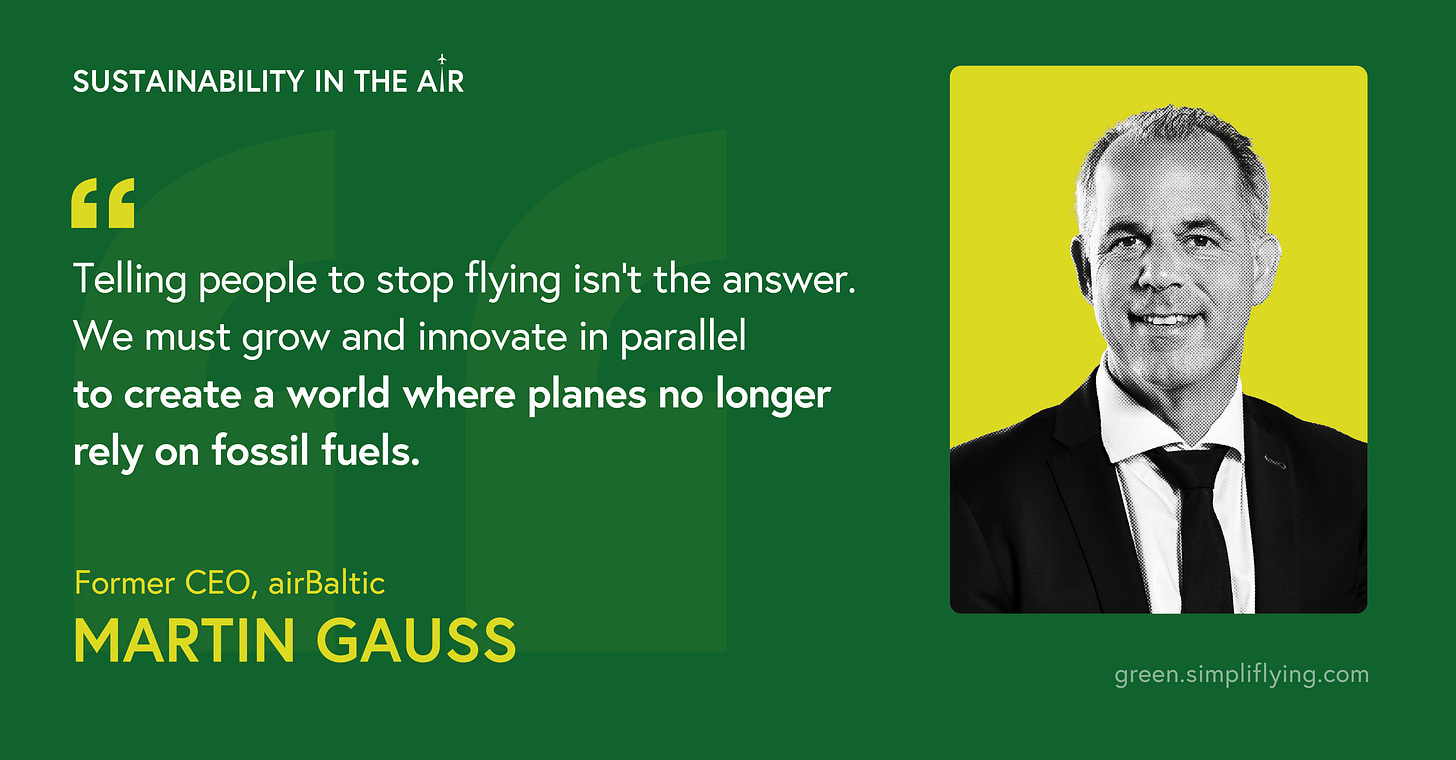In this episode of our Sustainability in the Air podcast, Martin Gauss, the former CEO of airBaltic, speaks with SimpliFlying’s CEO Shashank Nigam about building a future-ready airline from a small country with big ambitions.
AirBaltic is the flag carrier of Latvia and the largest airline in the Baltics, operating a fleet of Airbus A220 aircraft and connecting the region to key destinations across Europe and beyond. Under Gauss’s leadership, the airline became known for bold strategic bets — from being the first to commit to a 100% A220 fleet to introducing Starlink inflight internet in Europe.
Note: This interview was recorded just a week before Gauss stepped down as CEO. It offers a rare window into the thinking of a leader who helped redefine what a regional airline can achieve — and what it takes to lead on sustainability, innovation, and resilience.
Here are the key highlights of the conversation:
What it's like to lead as both a CEO and pilot (3:07)
Why airBaltic went all-in on the Airbus A220 (3:52)
The airline’s unique dual business model (9:58)
Making progress toward carbon neutrality by 2050 (12:45 & 16:40 & 21:30)
Starlink inflight internet and how a tweet sparked the partnership (14:43)
Innovations from small countries with big ambitions (24:24)
Lessons from dealing with engine supply chain disruptions (25:25)
The long-term case for sustainable aviation growth (28:08 & 31:13)
Rapid fire! (35:59)
Keep reading for a detailed overview of the episode.
How a pilot-turned-CEO transformed air travel in the Baltics
Martin Gauss has brought a hands-on, operational perspective to running an airline. A commercial pilot since 1992, he maintained his licence while leading airBaltic, staying connected to the technical side of the business.
Over more than a decade, Gauss shaped airBaltic’s strategy around fleet simplification, agile operations, and climate-forward thinking. From aircraft selection to digital innovation, his choices consistently reflected a long-term view of what regional aviation could become.
“We lead by example,” Gauss says. “And while we’re not yet carbon neutral, we’ve shown how it can be done — if you’re willing to invest, and to take risks.”
airBaltic’s regional dominance also expanded under his watch. The airline became the number one carrier in Riga and Tallinn, number two in Vilnius, and even the largest operator in Tampere, Finland’s second-largest city. This growth came despite a challenging backdrop of COVID-19 recovery and geopolitical instability. “We’re growing year on year, taking market share from competition and growing the market,” Gauss notes.
4 takeaways from the conversation
1. Betting early on fuel efficiency — and winning
airBaltic’s shift to an all-Airbus A220 fleet began in 2012, when the aircraft was still the Bombardier C-Series. Gauss recognised early on that a new-design aircraft could deliver both cost and environmental benefits.
“We were the launch operator of that aircraft,” he says. “If you look at the fuel flow, it has a 30% lower fuel flow than an equivalent older generation aircraft of that size.”
The decision to operate a single aircraft type improved efficiency, reduced complexity, and lowered emissions — all while supporting the airline’s path toward carbon neutrality. The fleet now stands out not only for its performance but also for its impact on passenger experience.
“We have a Net Promoter Score of 66… the European average of recorded airlines is 32. So we have double, actually,” Gauss shares.
airBaltic uses the A220s across a diverse network, including short 30-minute hops and long-haul leisure routes to Dubai and Tenerife. This wide range of deployment reinforces the fleet’s flexibility and carbon efficiency.
2. Rethinking the business model through operational flexibility
During the COVID-19 recovery, airBaltic began wet leasing surplus aircraft to other airlines. What started as a stopgap measure became a scalable model that allows the airline to use the same aircraft and crew across its own network and partner operations.
“Zurich is a good example,” Gauss explains. “We could fly Riga–Zurich with a crew and an airBaltic flight. And then in Zurich, you fly to Heathrow and back as a SWISS flight; and then back to Riga with the same crew.”
The model emerged in part due to necessity. When eastern markets closed during the war in Ukraine, airBaltic had five aircraft without immediate deployment options. Instead of parking them, the airline leased them to SAS and Lufthansa — a move that strengthened both its financial and environmental performance. The partnership has led Lufthansa Group to acquire a 10% stake in the airline.
While the airline has been facing external challenges — including ongoing supply chain issues affecting Pratt & Whitney engines — airBaltic’s performance demonstrates the strength of its model and its role in supporting regional connectivity. In 2024, the airline flew more than eight million passengers for the first time and achieved its highest-ever annual revenue.
“We remain committed to sustainable growth,” Gauss confirms. “Optimising the fleet and expanding the network is key to our future — and part of our long-term climate strategy as well.”
3. Sustainability with eyes wide open
Gauss sees sustainable aviation fuel (SAF) and new aircraft technologies as essential steps toward the industry’s 2050 net-zero target. He’s also realistic about current limitations — particularly on SAF supply, price, and passenger demand.
“We stick to the target to become carbon neutral by 2050 with a mix of using sustainable aviation fuel and new technologies,” he says. “Some of them we don't know yet… but they will come.”
In 2023, airBaltic was one of the first to introduce an option for passengers to purchase SAF when booking a ticket, yet last year only 0.32% chose to opt in. “Passengers today are not yet willing, at least not in Europe, to accept, to pay extra for it,” he explains.
airBaltic has focused on other levers too. The A220 supports optimised approaches, and the airline prioritises routes that make commercial and operational sense. Gauss notes that the fleet’s performance has also attracted sustainability-minded corporate customers.
Partnerships with manufacturers like Fokker NextGen (hydrogen) and Diamond Aircraft (electric) further signal a broader commitment to future flight technologies. The latter ties into the airline’s own electric ground operations and pilot academy, both of which are transitioning to fully electric platforms.
4. Innovation thrives on mindset, not size
Throughout the conversation, Gauss points to the Baltics’ role as a launchpad for new ideas — not because of scale, but because of speed and ambition.
“Latvia, 1.8 million people — small country in the Baltics. All of that was just pulled off by us in-house,” he says.
airBaltic has a history of adopting emerging technologies ahead of the curve — from accepting Bitcoin in 2014 to bringing artificial intelligence (AI) into revenue management and launching Starlink onboard Wi-Fi.
The latter began with a tweet to Elon Musk, followed by a conversation that aligned perfectly with SpaceX’s vision. “I flew over and I discussed my vision… and I hit the nail because that was at that time exactly their philosophy,” Gauss explains. After regulatory delays, the system launched in early 2025, and the fleet is expected to be fully equipped by the end of the year.
Final thoughts
Gauss led airBaltic through some of the most dynamic and uncertain periods in recent aviation history. He has done so with a focus on operational clarity, sustainability, and the belief that meaningful change is possible even in a small market.
“We should not always trust that it’s done by the big boys,” he tells us. “It could also be done by a small country with very smart technology.”
As airBaltic prepares for its next chapter with a potential IPO and further fleet expansion, it does so with a foundation built on innovation — and a CEO who flew the plane, literally and figuratively.
‘Sustainability in the Air’ is the world’s leading podcast dedicated to sustainable aviation. Through in-depth conversations with top aviation leaders, we break through the clutter and provide a clear roadmap for a net-zero future.













